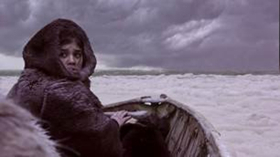Smithsonian Channel Probes New Theory That Rewrites the Story of North Americas First Humans

An astonishing discovery found jutting from an eroding coastal cliff on an island in the Chesapeake Bay in 2012 is challenging scientists' long-held theory about the first humans to inhabit North America - where they originated, and how and when they arrived. It points to an explosive theory: Ice Age people made an epic journey across a massive ice bridge spanning a frozen Atlantic about six thousand years before people trekked across what is now the Bering Strait. The extraordinary find could rewrite history and upend our understanding of early human migration. Using archaeology, geology and genetics, a new one-hour documentary follows the expedition and search to uncover new evidence that could unravel the 20,000-year-old mystery. The film uses re-creation and state-of-the-art CGI to bring to life the ancient frozen wilderness and the fearsome Ice Age beasts that once ruled our continent. ICE BRIDGE: THE IMPOSSIBLE JOURNEY premieres Wednesday, April 18 at 8 p.m. ET/PT on Smithsonian Channel.
It is widely believed that the first migrants to North America arrived approximately 14,000 years ago, having walked across a land bridge from Siberia to Alaska in the West. In ICE BRIDGE: THE IMPOSSIBLE JOURNEY, new evidence supports an extraordinary theory of another trip to the New World: a trans-Atlantic crossing six thousand years earlier by travelers from mainland Europe to the eastern coast of North America. Renowned archaeologists Dennis Stanford, from Smithsonian's National Museum of Natural History, and Bruce Bradley, from University of Exeter, gain special access to a private island off the east coast of Maryland, where a treasure trove of stone artifacts-bifaces, blades and projectiles believed to be 20,000 years old-has been discovered. In a race against time, they lead a team of international scientists on an urgent mission to excavate the crumbling 20-foot cliff before the site vanishes - washed away by the rising tides. The new discoveries could change everything known about the earliest human inhabitants of our continent and how they arrived here.
Who were these people? The artifacts found at the site indicate an ancient culture capable of making sophisticated tools, and the film follows the researchers as they go in search of evidence of innovative, skillful hunters able to manufacture such weapons. Bradley travels to Europe to examine an 80,000-year-old cave in the Pyrenees, which may support the connection between a group of Ice Age hunters and the sea. These hunters were called the Solutreans, and, as Stanford and Bradley discover, the tools they made are nearly identical to the ones found in the Chesapeake. Could these Western Europeans have crossed the frigid Atlantic Ocean thousands of years before Columbus and the Vikings?
Despite challenges from the scientific community, both Stanford and Bradley are staking their reputations on the theory. It will take irrefutable evidence to persuade the skeptics, but in the meantime, the scientists continue to search at the dig site, believing that one day the final proof will come for one of humanity's monumental achievements and greatest journeys.
As Stanford and Bradley search for evidence, ICE BRIDGE: THE IMPOSSIBLE JOURNEY also pursues a genetic detective story. Geneticist Stephen Oppenheimer and his team at Huddersfield University spend months tracing unique mitochondrial DNA found in many North Americans back to the Solutrean region. The team gains rare permission to work with a singular Native American tribe, the Huron-Wendat, and is granted an unprecedented exception to sequence the sacred remains of 40 pre-Columbian ancestors for a genetic study. Oppenheimer's group achieves some exciting results while searching for a genetic marker prevalent in Europe 20,000 years ago as a way to establish clear evidence that people possessing the isolated gene came to North America from across the Atlantic.
ICE BRIDGE: EXPEDITION ACROSS THE ATLANTIC is a production of Yap Films for Smithsonian Channel in association with the Canadian Broadcasting Corporation, France Télévisions, and Yesterday, UKTV, with Robin Bicknell directing and executive producers Elliot Halpern and Elizabeth Trojian. Executive producers for Smithsonian Channel are John Cavanagh, Charles Poe and David Royle.
Smithsonian Channel™, owned by Smithsonian Networks™, a joint venture between Showtime Networks Inc. and the Smithsonian Institution, is where curiosity lives, inspiration strikes and wonders never cease. This is the place for awe-inspiring stories, powerful documentaries and amazing entertainment across multiple platforms. Smithsonian Channel combines the storytelling prowess of SHOWTIME® with the unmatched resources and rich traditions of the Smithsonian, to create award-winning programming that shines new light on popular genres such as air and space, history, science, nature, and pop culture. Among the network's offerings are series including Aerial America, America in Color, First Ladies Revealed, Polar Bear Town, The Lost Tapes, Amazing Monkeys, America's Secret Space Heroes, Mighty Ships, Mighty Planes and Air Disasters, as well as critically-acclaimed specials that include Titanic's Fatal Fire, The Obama Years: The Power of Words, Nightmare on Everest, Diana and the Paparazzi, Diana: The Day We Said Goodbye and Flying High with Phil Keoghan. Smithsonian Networks also operates Smithsonian Earth™, through SN Digital LLC., a new subscription video streaming service delivering spectacular original nature and wildlife content. To learn more, go to www.smithsonianchannel.com, or connect with us on Facebook, Twitter, and Instagram.
Comments
Videos

